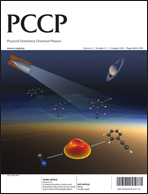RCCSD(T) and/or CASSCF/MRCI calculations were carried out on the ![[X with combining tilde]](https://www.rsc.org/images/entities/char_0058_0303.gif) 2B1 state of AsF2, the
2B1 state of AsF2, the ![[X with combining tilde]](https://www.rsc.org/images/entities/char_0058_0303.gif) 1A1, ã3B1 and Ã1B1 states of AsF2+, and the
1A1, ã3B1 and Ã1B1 states of AsF2+, and the ![[X with combining tilde]](https://www.rsc.org/images/entities/char_0058_0303.gif) 1A1 state of AsF2− employing the fully-relativistic small-core effective core potential (ECP10MDF) for As and basis sets of up to augmented correlation-consistent polarized valence quintuple-zeta (aug-cc-pV5Z) quality. Minimum-energy geometrical parameters and relative electronic energies were evaluated, including contributions from extrapolation to the complete basis set limit and from outer core correlation of the As 3d10 electrons. In addition, simplified, explicitly correlated RHF/UCCSD(T)-F12x calculations were also performed employing different atomic orbital basis sets, and associated complementary auxiliary and density-fitting basis sets. The best theoretical estimates of the adiabatic ionization energies (AIE0) of AsF2(
1A1 state of AsF2− employing the fully-relativistic small-core effective core potential (ECP10MDF) for As and basis sets of up to augmented correlation-consistent polarized valence quintuple-zeta (aug-cc-pV5Z) quality. Minimum-energy geometrical parameters and relative electronic energies were evaluated, including contributions from extrapolation to the complete basis set limit and from outer core correlation of the As 3d10 electrons. In addition, simplified, explicitly correlated RHF/UCCSD(T)-F12x calculations were also performed employing different atomic orbital basis sets, and associated complementary auxiliary and density-fitting basis sets. The best theoretical estimates of the adiabatic ionization energies (AIE0) of AsF2(![[X with combining tilde]](https://www.rsc.org/images/entities/char_0058_0303.gif) 2B1) to the
2B1) to the ![[X with combining tilde]](https://www.rsc.org/images/entities/char_0058_0303.gif) 1A1 and ã3B1 states of AsF2+, including corrections for zero-point vibrational energy (ΔZPE), are 9.099(8) and 13.290(22) eV respectively. The best estimated electron affinity (EA0) of AsF2 is 1.182(16) eV, also including Δ(ZPE). These are currently the most reliable AIE0 and EA0 values for AsF2. Potential energy functions (PEFs) of the
1A1 and ã3B1 states of AsF2+, including corrections for zero-point vibrational energy (ΔZPE), are 9.099(8) and 13.290(22) eV respectively. The best estimated electron affinity (EA0) of AsF2 is 1.182(16) eV, also including Δ(ZPE). These are currently the most reliable AIE0 and EA0 values for AsF2. Potential energy functions (PEFs) of the ![[X with combining tilde]](https://www.rsc.org/images/entities/char_0058_0303.gif) 2B1 state of AsF2, the
2B1 state of AsF2, the ![[X with combining tilde]](https://www.rsc.org/images/entities/char_0058_0303.gif) 1A1 and ã3B1 states of AsF2+ and
1A1 and ã3B1 states of AsF2+ and ![[X with combining tilde]](https://www.rsc.org/images/entities/char_0058_0303.gif) 1A1 state of AsF2− were computed at RCCSD(T)/aug-cc-pV5Z, RCCSD(T)/aug-cc-pCV5Z and RHF/UCCSD(T)-F12a/aug-cc-pCVTZ levels. These PEFs were employed in variational calculations of anharmonic vibrational wavefunctions, which were then utilised to calculate Franck–Condon factors (FCFs), using a method which includes allowance for anharmonicity and Duschinsky rotation. The computed FCFs were used to simulate the first two bands in the photoelectron spectrum of AsF2 and the first band in the photodetachment spectrum of AsF2−, both yet to be recorded. The simulated spectra obtained using different sets of PEFs were found to be almost identical, suggesting that the simplified explicitly correlated UCCSD(T)-F12x method with a relatively small basis set can be a reliable alternative to the conventional RCCSD(T) correlation methods with a relatively large basis set, but at a significantly lower cost.
1A1 state of AsF2− were computed at RCCSD(T)/aug-cc-pV5Z, RCCSD(T)/aug-cc-pCV5Z and RHF/UCCSD(T)-F12a/aug-cc-pCVTZ levels. These PEFs were employed in variational calculations of anharmonic vibrational wavefunctions, which were then utilised to calculate Franck–Condon factors (FCFs), using a method which includes allowance for anharmonicity and Duschinsky rotation. The computed FCFs were used to simulate the first two bands in the photoelectron spectrum of AsF2 and the first band in the photodetachment spectrum of AsF2−, both yet to be recorded. The simulated spectra obtained using different sets of PEFs were found to be almost identical, suggesting that the simplified explicitly correlated UCCSD(T)-F12x method with a relatively small basis set can be a reliable alternative to the conventional RCCSD(T) correlation methods with a relatively large basis set, but at a significantly lower cost.
![[X with combining tilde]](https://www.rsc.org/images/entities/char_0058_0303.gif) 2B1 state of AsF2, the
2B1 state of AsF2, the ![[X with combining tilde]](https://www.rsc.org/images/entities/char_0058_0303.gif) 1A1, ã3B1 and Ã1B1 states of AsF2+, and the
1A1, ã3B1 and Ã1B1 states of AsF2+, and the ![[X with combining tilde]](https://www.rsc.org/images/entities/char_0058_0303.gif) 1A1 state of AsF2− employing the fully-relativistic small-core effective core potential (ECP10MDF) for As and basis sets of up to augmented correlation-consistent polarized valence quintuple-zeta (aug-cc-pV5Z) quality. Minimum-energy geometrical parameters and relative electronic energies were evaluated, including contributions from extrapolation to the complete basis set limit and from outer core correlation of the
1A1 state of AsF2− employing the fully-relativistic small-core effective core potential (ECP10MDF) for As and basis sets of up to augmented correlation-consistent polarized valence quintuple-zeta (aug-cc-pV5Z) quality. Minimum-energy geometrical parameters and relative electronic energies were evaluated, including contributions from extrapolation to the complete basis set limit and from outer core correlation of the ![[X with combining tilde]](https://www.rsc.org/images/entities/char_0058_0303.gif) 2B1) to the
2B1) to the ![[X with combining tilde]](https://www.rsc.org/images/entities/char_0058_0303.gif) 1A1 and ã3B1 states of AsF2+, including corrections for zero-point vibrational energy (ΔZPE), are 9.099(8) and 13.290(22) eV respectively. The best estimated electron affinity (EA0) of AsF2 is 1.182(16) eV, also including
1A1 and ã3B1 states of AsF2+, including corrections for zero-point vibrational energy (ΔZPE), are 9.099(8) and 13.290(22) eV respectively. The best estimated electron affinity (EA0) of AsF2 is 1.182(16) eV, also including ![[X with combining tilde]](https://www.rsc.org/images/entities/char_0058_0303.gif) 2B1 state of AsF2, the
2B1 state of AsF2, the ![[X with combining tilde]](https://www.rsc.org/images/entities/char_0058_0303.gif) 1A1 and ã3B1 states of AsF2+ and
1A1 and ã3B1 states of AsF2+ and ![[X with combining tilde]](https://www.rsc.org/images/entities/char_0058_0303.gif) 1A1 state of AsF2− were computed at
1A1 state of AsF2− were computed at 

 Please wait while we load your content...
Please wait while we load your content...